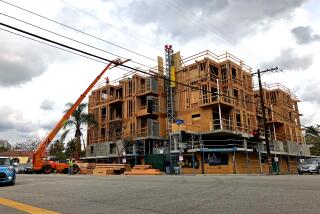Los Angeles City Council gives final approval to housing rezoning plan

- Share via
The Los Angeles City Council on Friday granted final approval to a sweeping rezoning plan that aims to boost housing development along commercial corridors and existing dense residential neighborhoods.
In a 14-to-0 vote, council members approved the so-called Citywide Housing Incentive Program.
The new ordinance will provide developers incentives to build both market rate and affordable units. It represents Los Angeles’ main strategy to meet state housing goals that require the city to find land where an additional 255,000 homes can be built.
The unanimous vote Friday comes as the city faced a state deadline of next week to have a housing plan in place and it caps a years-long process that was entangled with questions over equity, traffic and the layout of the city.
Under the Citywide Housing Incentive Program, commonly referred to as the CHIP Ordinance, developers will be able to exceed current limits on building if they include a certain percentage of affordable units in their new development and the property is near public transit.
Projects that are 100% affordable will be eligible for incentives across a wider swath of the city.
In both cases, developers can generally only use the incentives if a property is in an existing multifamily neighborhood or commercial zone.
Single-family zones will be left largely untouched, unless property is owned by a public agency or a faith-based organization, which accounts for just a sliver of the city’s single-family lots.
Explore the latest prices for homes and rentals in and around Los Angeles.
The Planning Department originally explored allowing much more building in single-family neighborhoods, which was supported by tenant and equity groups that wanted low-income housing in these areas to combat a legacy of segregation.
The department, however, dropped the plans following pushback from homeowner groups concerned over changes to their neighborhoods, including traffic and noise. In December, the City Council rejected a late effort to shift course, though some council members expressed interest in opening single-family neighborhoods to a limited amount of new development in the future.
Tenant groups have said focusing redevelopment in areas that already allow multifamily housing could lead to mass displacement, as developers knock down existing apartments to build newer, bigger buildings.
The Planning Department has said it tried to address concerns over equity and displacement in a few ways.
It allowed developers greater incentives if their lots are in commercial strips and multifamily neighborhoods that are also near jobs and good schools.
And separate tenant protection rules passed Friday give low-income residents displaced by demolition the right to move into the new development at either their prior rent or at rent deemed affordable to their income, whichever is lower.
Those residents would typically receive expanded relocation assistance to help them afford rent in a market-rate unit for 42 months, the average time it takes to build a new apartment building, according to the city.
More to Read
Sign up for Essential California
The most important California stories and recommendations in your inbox every morning.
You may occasionally receive promotional content from the Los Angeles Times.












